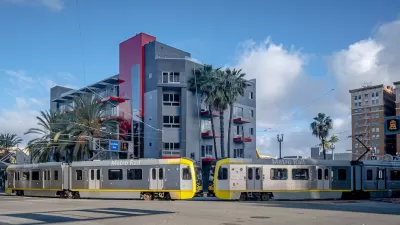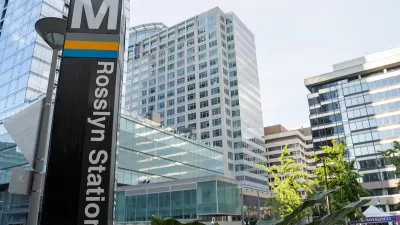City officials are deciding how to change parking requirements for transit-oriented developments that are meant to discourage private car ownership.

As the city of Austin finalizes its equitable transit-oriented development (eTOD) plan, some officials are urging their peers to change parking requirements near transit stations, reports Jonathan Lee in the Austin Monitor.
João Paulo Connolly, a member of the Project Connect Community Advisory Committee, “said that eliminating parking minimums is ‘an absolute baseline must,’” urging the city council to also adopt maximum parking requirements. “By making developers build as little parking as possible near transit stations, such policies would mean people are more likely to ditch their cars for trains or buses, Connolly and others argued.”
The eTOD plan proposes three ways to reform parking requirements: eliminating minimums, creating parking maximums, and including parking in floor area ratio (FAR) calculations. The change in FAR is the most controversial of the proposed changes. “According to city staffers, some stakeholders said the policy could prevent some projects from obtaining financing. In response, staffers recommend against adopting the policy.”
Other policies promoted by the eTOD plan include density bonuses, the preservation of existing affordable housing, and incentives to help small businesses open in TODs.
FULL STORY: Transit-oriented development plan prompts parking discussions

Maui's Vacation Rental Debate Turns Ugly
Verbal attacks, misinformation campaigns and fistfights plague a high-stakes debate to convert thousands of vacation rentals into long-term housing.

Planetizen Federal Action Tracker
A weekly monitor of how Trump’s orders and actions are impacting planners and planning in America.

In Urban Planning, AI Prompting Could be the New Design Thinking
Creativity has long been key to great urban design. What if we see AI as our new creative partner?

King County Supportive Housing Program Offers Hope for Unhoused Residents
The county is taking a ‘Housing First’ approach that prioritizes getting people into housing, then offering wraparound supportive services.

Researchers Use AI to Get Clearer Picture of US Housing
Analysts are using artificial intelligence to supercharge their research by allowing them to comb through data faster. Though these AI tools can be error prone, they save time and housing researchers are optimistic about the future.

Making Shared Micromobility More Inclusive
Cities and shared mobility system operators can do more to include people with disabilities in planning and operations, per a new report.
Urban Design for Planners 1: Software Tools
This six-course series explores essential urban design concepts using open source software and equips planners with the tools they need to participate fully in the urban design process.
Planning for Universal Design
Learn the tools for implementing Universal Design in planning regulations.
planning NEXT
Appalachian Highlands Housing Partners
Mpact (founded as Rail~Volution)
City of Camden Redevelopment Agency
City of Astoria
City of Portland
City of Laramie





























